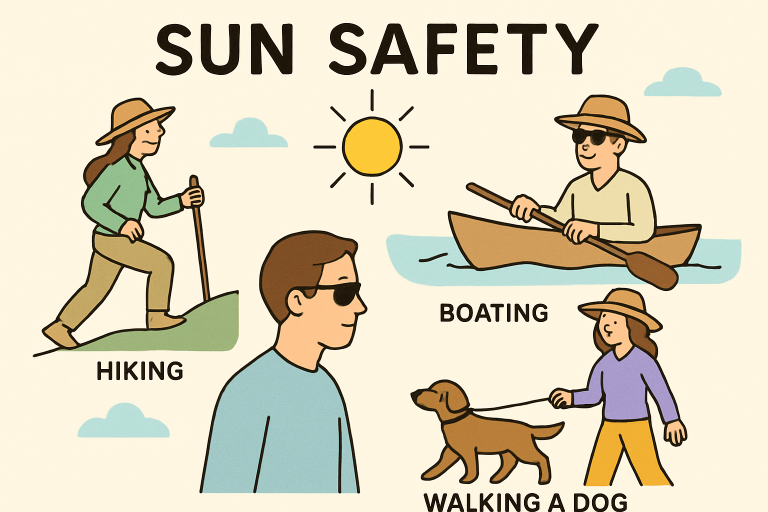Post Preview
Sun protection influences how we live, work, and play outdoors, protecting our comfort and health. Whether enjoying a picnic, hiking, or boating, incorporating sun safety into each activity helps keep outdoor time enjoyable. For full-day water outings, a boat shade extension offers all-day comfort and ease of maintenance. Daily routines, such as errands or walking the dog, expose us to UV radiation, making sun protection essential. Cultivating sun-safe habits can boost confidence, enable exploration, and reduce the risk of skin damage. Proactive sun care enhances outdoor experiences by prioritizing fun over worrying about sunburn and discomfort.
Understanding UV Radiation
Ultraviolet (UV) radiation is an invisible form of energy given off by the sun. While a modest amount of sun exposure is necessary for processes such as vitamin D synthesis, excessive exposure can lead to health consequences. The two main types of UV rays responsible for skin damage are UVA and UVB.
UVA rays penetrate deeply into the skin, leading to premature aging, while UVB rays cause surface burns and are responsible for the majority of skin cancers. Even on cloudy days, up to 80% of UV rays can reach the earth and our skin, making sun protection necessary year-round. For those spending extended time outdoors, using a universal boat shade extension for all-day comfort can provide adequate coverage, helping to reduce UV exposure while enjoying outdoor activities safely.
Health Risks of UV Exposure
Too much exposure to UV radiation dramatically increases the risk of developing skin cancers, including melanoma, which is one of the deadliest forms. Consistent unprotected exposure to the sun can also accelerate skin aging, produce unsightly sunspots, and compromise eye health by increasing the risk of cataracts. The World Health Organization notes that even brief, intense exposures can have severe long-term impacts on skin health.
Effective Sun Protection Strategies
To effectively protect yourself from UV radiation while enjoying outdoor activities, prioritize shade during peak UV intensity hours from 10 a.m. to 4 p.m. When shade is scarce, use wide-brimmed hats and UV-protective sunglasses to shield vulnerable areas, such as the face and eyes. Additionally, opt for long sleeves and pants crafted from tightly woven fabrics, and consider clothing with a certified Ultraviolet Protection Factor (UPF) label. Finally, consistently apply a broad-spectrum sunscreen with an SPF of 30 or more, regardless of the season or weather conditions.
Sun-Protective Clothing
Innovations in textile technology, including the creation of specialized UPF fabrics, have revolutionized sun-safe fashion. These garments not only block out harmful rays but are also comfortable and breathable, ideal for outdoor enthusiasts and anyone who works outside. Renowned outdoor apparel brands, such as Mountain Hardwear, have introduced entire collections featuring UPF 50+ ratings, setting a new standard in sun-protective wear for adventurers and families alike.
Incorporating these clothing options into your wardrobe is a passive and straightforward way to ensure continuous sun safety, especially in environments where reapplying sunscreen may not be convenient.
Sunscreen Application Tips
The effectiveness of sunscreen depends on its proper application and consistent use. Dermatologists agree that you should apply sunscreen at least 15 minutes before heading outdoors, using approximately one ounce to cover all exposed skin. Reapplication is critical—every two hours, or more often if you’re sweating or swimming. Be especially diligent in high-risk areas, such as the face, ears, tops of the feet, neck, and hands.
Incorporating Sun Safety into Daily Life
Making sun safety an everyday habit is easier when supplies like sunscreen, hats, and sunglasses are always within reach. Consider keeping travel-size sunscreen in your bag or car and setting reminders to reapply during prolonged outdoor periods. Routinely scheduling outdoor plans for early morning or late afternoon hours, when UV intensity is lower, provides both safety and comfort without missing out on the joys of the sun. Adopting a lifestyle of sun mindfulness promotes better health outcomes and encourages loved ones to follow your example, transforming individual actions into a culture of collective well-being.
Educating Children on Sun Safety
Initiating sun-safe education early is crucial for maintaining long-term health. Interactive programs and school initiatives provide valuable resources and practical tips for parents and teachers. Teach children to apply and reapply sunscreen, seek shade, and wear hats and sunglasses as a fun and regular part of their daily routine for playtime. Building consistent routines during childhood fosters a foundation for a lifetime of sun-smart habits.
Conclusion
Intentional sun protection empowers people to confidently embark on every outdoor adventure, knowing they’re taking steps to prevent skin damage, premature aging, and an increased risk of cancer. By weaving simple yet powerful sun safety strategies into daily routines and family activities, we can fully enjoy the beauty and excitement of the outdoors—without compromise.






